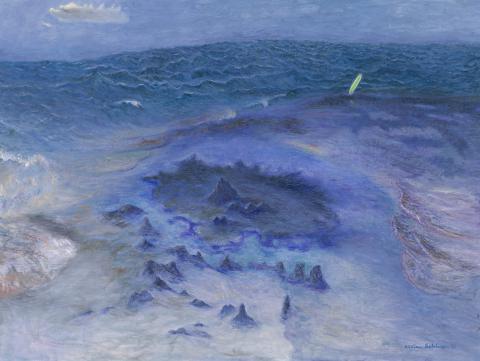SEASCAPE WITH SURFBOARD, 1996
WILLIAM ROBINSON
oil on canvas
76.5 x 102.0 cm
signed and dated lower right: William Robinson 96
inscribed with title verso: SEASCAPE WITH SURFBOARD …
Ray Hughes Gallery, Sydney
Verity Lambert, London, acquired from the above in 1996
Sotheby’s, Melbourne, 24 November 2008, cat. 31
Private collection, Queensland
William Robinson, Ray Hughes Gallery, Sydney, 28 June – 24 July 1996, cat. 16 (illus. in exhibition catalogue)
Painted in 1996, Seascape with Surfboard belongs to a group of paintings that stand alone amongst Robinson’s oeuvre. Gone are the epic landscapes depicting the ancient rainforests of northern New South Wales for which the artist is best known and instead we have images of heaving seas against delicate sands. For Robinson, the years leading up to this time were hugely successful. Regular exhibitions, critical acclaim, the demands of collectors and galleries along with white hot attention of the public eye, following two Archibald prize wins, would have entitled Robinson to a period of introspection. And so in 1994, with a move to Kingscliff on the coast near Fingal Bay, the immersive bush landscape was replaced by the view out to sea. Instead of Robinson’s forensic observations of the forested landscapes he now found the sea, sky and seashore to be an abiding subject. With a nod to impressionism, the artist describes the sea change...
‘…Living at the sea for a good part of my time gives me a chance to see the changing moods of the sea and sky. These are almost the only two elements and they interact with reflective light constantly. In the sea paintings I am always trying to give a feeling of relentless and powerful movement clothed in great beauty... The fleeting sensation of luminous sea, wet sand and darkening dry sand with the last of disappearing people produced real paintings possible for me... The seascape has a passing ephemeral quality... When walking at the seashore I observe the movement to darkness. For a short moment before this, a violet of most ravishing beauty appeared at the line between dry and wet sane caused by a retreating wave. This vision will always remain with me’.1
Key to Seascape with Surfboard, 1996, is the series of sandcastles in the centre of the composition which are being reclaimed by the sea whipped up by a strong westerly. Prehistoric in form, these remnants of a day’s play now past, are powerful inclusions within the composition, evoking a melancholy mood and a reminder that we are each at the mercy of forces beyond our control, and perhaps understanding. The surfboard being tossed high from the waves is perhaps a moment of mirth or on the other hand a further symbol of the power of nature over man.
William Robinson’s seascape paintings exhibit an introspective quality, unlike his interior landscapes, these works look inwards towards a spiritual place and are carried by an emotional weight that heaves as heavily as the sea they depict. Perhaps the great German romantic, Casper David Friedrich, understood it best when he said, ‘…close your bodily eye so that you may see your picture first with the spiritual eye. Then bring to the light of day that which you have seen in the darkness so that it may react upon others from the outside inwards’.2
1. Robinson, W., in Klepac, L., William Robinson: Paintings 1987 – 2000, The Beagle Press, Sydney, 2001, p. 114
2. Freidrich, C., quoted in Vaughan, W., German Romantic Painting, Yale, New Haven, 1980, p. 68
HENRY MULHOLLAND
